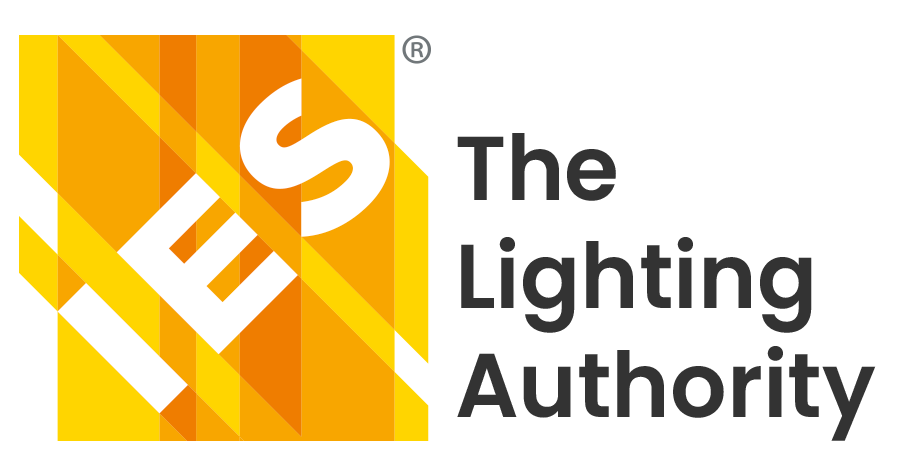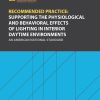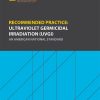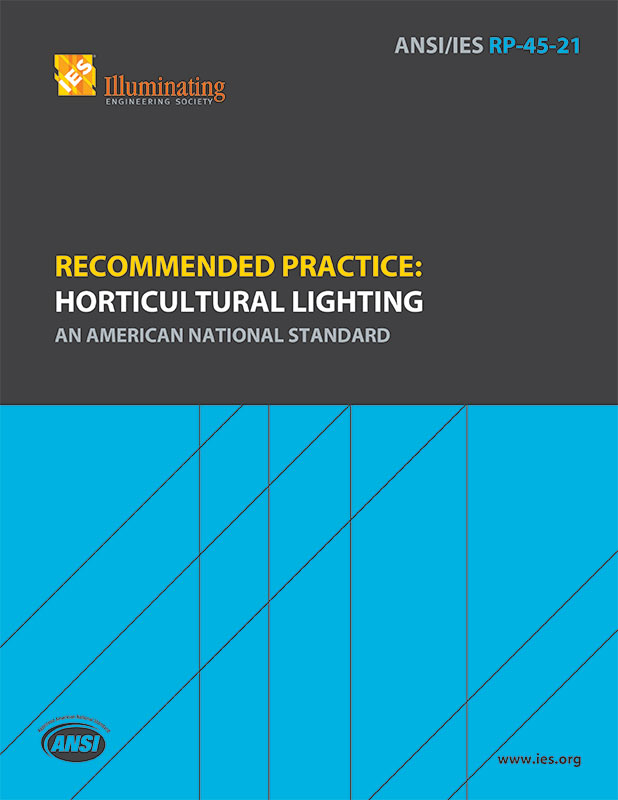Recommended Practice: Horticultural Lighting
$120.00
Member Price: $90.00
ANSI/IES RP-45-21
Document Type: Recommended Practice (RP)
Available as a downloadable secure PDF only.
To stay current with all IES standards, we recommend subscribing to the The Lighting Library as an Individual or through your company as a Sustaining Member.
In stock
Product Description
 While humans and plants use light in different ways and for different reasons, the fundamental job of the lighting professional for these applications stays the same—to deliver the right amount of light with appropriate spectral power distribution to the target at the right time. The amount of light is characterized differently for plant versus human applications. For plants, the amount of irradiation, the timing of delivery, and the total light dose over the course of a day and throughout the plant life cycle need to be considered. The appropriate spectral power distribution is different for plants and humans—and can vary between plant species (and even between different cultivars within a species). This document describes these differences between architectural and horticultural lighting design, so that lighting professionals will have the necessary information to translate their architectural lighting know-how into horticultural lighting practice.
While humans and plants use light in different ways and for different reasons, the fundamental job of the lighting professional for these applications stays the same—to deliver the right amount of light with appropriate spectral power distribution to the target at the right time. The amount of light is characterized differently for plant versus human applications. For plants, the amount of irradiation, the timing of delivery, and the total light dose over the course of a day and throughout the plant life cycle need to be considered. The appropriate spectral power distribution is different for plants and humans—and can vary between plant species (and even between different cultivars within a species). This document describes these differences between architectural and horticultural lighting design, so that lighting professionals will have the necessary information to translate their architectural lighting know-how into horticultural lighting practice.
Page count: 55 pages
Publisher: Illuminating Engineering Society (2021)
SKU: ANSI/IES RP-45-21
ISBN-13: 978-0-87995-409-3
Chapters:
- 1.0 Introduction and Scope
2.0 Normative References
3.0 Definitions
4.0 Botany Overview
5.0 Describing the Spectra of Optical Radiation
6.0 Light Sources and Luminaires
7.0 Daylight
8.0 Controlled Environments
9.0 Agricultural Films
10.0 Optical Sensors
Citation Format:
Illuminating Engineering Society. ANSI/IES RP-45-21, Recommended Practice: Horticultural Lighting. New York: IES; 2021.
CONTENTS
- 1.0 Introduction and Scope
- 1.1 Introduction
- 1.2 Scope
- 2.0 Normative References
- 2.1 ANSI/ASABE S640 JUL2017
- 2.2 ANSI/ASABE S642 SEP2018
- 2.3 ANSI/CAN/UL 8800:2019
- 2.4 ANSI/IEC 60529
- 2.5 ANSI/IES LS-1-20
- 2.6 IEC/TR 62471-2
- 2.7 NFPA 70
- 2.8 SI Brochure, 9th ed.
- 3.0 Definitions
- 4.0 Botany Overview
- 4.1 Plant Anatomy
- 4.2. Photobiology
4.2.1 Photosynthesis
4.2.2 Photomorphogenesis
4.2.3 Phototropism
4.2.4 Shade Avoidance
4.2.5 Circadian Rhythms
4.2.6 Secondary Metabolites - 4.3 Other Growth and Development Parameters
- 5.0 Describing the Spectra of Optical Radiation
- 5.1 Action Spectra
- 5.2 Spectral Regions
5.2.1 Ultraviolet-C (Wavelengths 100 to 280 nm)
5.2.2 Ultraviolet-B (280 to 315 nm)
5.2.3 Ultraviolet-A (315 to 400 nm)
5.2.4 Blue (400 to Approximately 500 nm)
5.2.5 Green (Approximately 500 to Approximately 530 nm)
5.2.6 Yellow (Approximately 530 to 600 nm)
5.2.7 Red (Approximately 600 to 700 nm)
5.2.8 Far-red (700 to 800 nm)
5.2.9 Infrared (Longer Than 800 nm) - 5.3 Photoperiod
5.3.1 Long-Day and Short-Day Plants
5.3.2 Daily Light Integral - 5.4 Alternative Design Considerations
5.4.1 Diffuse Glazing
5.4.2 Inter-row and Intra-row Lighting
5.4.3 Upwardly Directed Light - 5.5 Pulsed Light
5.5.1 Pulse Width Modulation
5.5.2 Sunflecks - 5.6 Light Recipes
- 6.0 Light Sources and Luminaires
- 6.1 Lamps and Modules
6.1.1 Light-Emitting Diodes
6.1.2 High Pressure Sodium
6.1.3 Metal Halide
6.1.4 Fluorescent
6.1.5 Induction
6.1.6 Incandescent - 6.2 Optics
6.2.1 Photon Intensity Distribution
6.2.2 PPFD Uniformity
6.2.3 Photobiological Risks - 6.3 Housings
6.3.1 IP and IK Ratings
6.3.2 Passive and Active Cooling
6.3.3 Chemical Corrosion - 6.4 Electrical Considerations
6.4.1 Power Factor
6.4.2 Inrush Current
6.4.3 Surge Protection
6.4.4 Controls - 6.5 Reliability Considerations
- 7.0 Daylight
- 7.1 Direct Sunlight
- 7.2 Diffuse Daylight
- 7.3 Plant Requirements
- 7.4 Weather
7.4.1 Cloud Cover and Wind
7.4.2 Climate Data - 8.0 Controlled Environments
- 8.1 Greenhouses and Polytunnels
8.1.1 Site Considerations
8.1.2 Glazing
8.1.3 Roof Styles
8.1.4 Shades
8.1.5 Energy Curtains
8.1.6 Light Pollution - 8.2 Vertical Farms
- 8.3 Government Regulations
8.3.1 Lighting Power Density
8.3.2 Luminaire Efficacy - 9.0 Agricultural Films
- 9.1 Ultraviolet-Blocking Films
- 9.2 Thermic Films
- 9.3 Near-Infrared-Blocking Films
- 9.4 Transmittance Properties
- 9.5 Diffusion Properties
- 9.6 Photoselective Films
- 10.0 Optical Sensors
- 10.1 PAR (Quantum) Sensors
- 10.2 Spectroradiometers
- 10.3 Illuminance Meters
- Annex A – Light Interactions
- Annex B – Recommended Daily Light Integrals
- Annex C – Lighting Design Process for Horticultural Lighting Projects
- Annex D – Atria and Plants
- References



